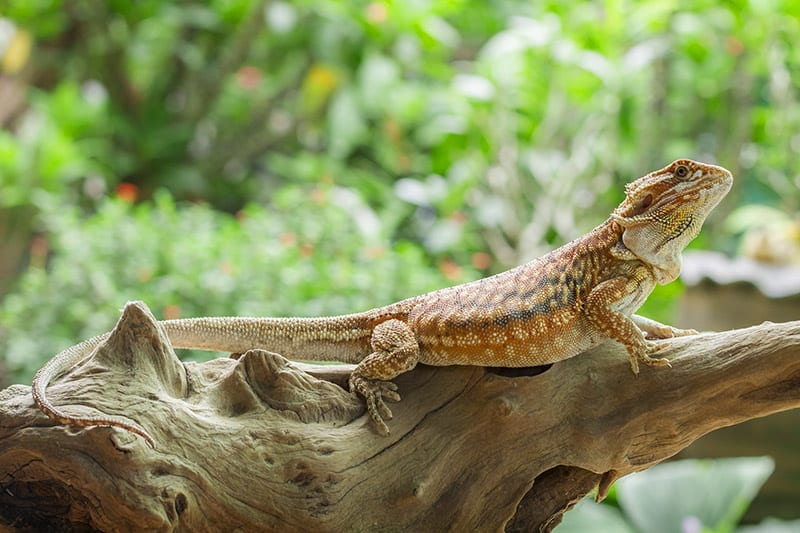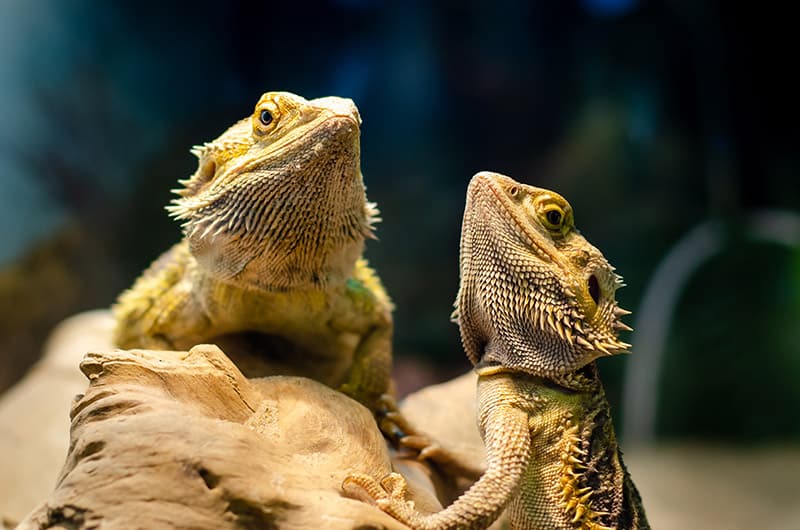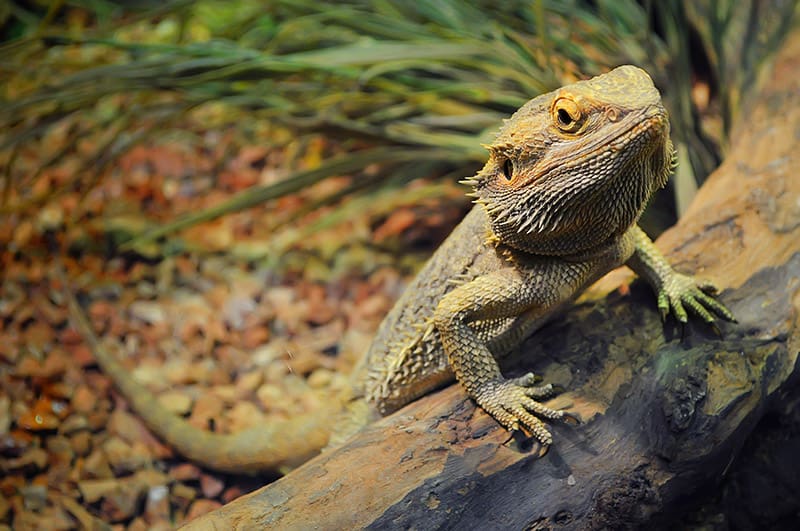What is a Bearded Dragon?… a medium sized pet lizard, but with a cool, spiny “beard”!
True to their name, Bearded Dragons have a spiny ‘beard’. A male Bearded Dragon will present its ‘beard’ when making defensive displays and during courtship behavior. Though both the male and female have a beard, the male’s is usually more pronounced and darker than that of the female’s.
The Bearded Dragon is also known as the Australian Bearded Dragon, Inland Bearded Dragon, and Central Bearded Dragon. In the last ten years, this Agama lizard has become an incredible herpetocultural success story. It has flourished in popularity and in successful keeping along with other favorite pet reptiles such as the Leopard Gecko, Crested Gecko, Ball Python, and the Cornsnake.
Beardies are now being bred in such numbers that it is being genetically manipulated for color, temperament, and even size. “Blood Red”, “High Orange”, “Peach”, Tiger-striped”, “Hypomelanistic”, “Lemon Yellow”, “White”, and other color morphs are being produced, advertised, and sold.
Adult bearded dragons average 15″ to 17″ in length, though there are reports of large males reaching up to 23″ (Robert Mailloux, Sandfire Dragon Ranch).
Though Bearded Dragon babies are slightly nervous, they grow can grow into a calm, easy-going pet lizards. These are some of the best reptile pets as they are hardy, very docile, and easy to care for.
- For more Information on pet lizards see: Reptile Care – Keeping Reptiles and Amphibians as Pets
Scientific Classification
| Kingdom: | Animalia |
| Phylum: | Chordata |
| Class: | Reptilia |
| Order: | Squamata |
| Family: | Agamidae |
| Genus: | Pogona |
| Species: | vitticeps |
Scientific Name

Habitat: Distribution/Background
The Bearded Dragon Pogona vitticeps was described by Ernst Ahl in 1926. The Bearded Dragon is native to Australia, where they inhabit a sunny, hot, and arid environment. Other common names they are known by are Australian Bearded Dragon, Inland Bearded Dragon, and Central Bearded Dragon.
Status
The Pogona vitticeps is not on the IUCN Red List for Endangered Species.
Description
Adult Bearded Dragons average 15″ to 17″ (38 – 43 cm) in length. Bearded Dragons hatch out at 3″ to 4″ and grow quickly, many reaching sexual maturity as early as one year old. They have a gray, brown, or orangish-brown overall coloring on a somewhat flattened body, with a grayish colored underside. There are prominent spines along the sides and they have a large triangular shaped head. The most notable characteristic, true to their name, is their bearded appearance when they puff out their throat area. The beard is especially prominent on adult males during courtship.
See more Pictures of regular and color morphs below under: Breeding
Note: It had long been thought that the Gila Monsters and the Beaded lizards, in the Family Helodermatidae, were the only venomous lizards. But more recently it has been discovered that a couple other groups of lizards also contain venomous lizards including some in the Family Agamidae, like the Bearded Dragon. For pet owners there is no reason for undue concern, however, as the toxin secreting glands of these lizards are smaller than those of snakes. The venom they produce may aid to subduing small prey, but on a human it would have no effect, or very little. It is said that a bitten hand might throb at most.
Food and Feeding
Feeding captive Bearded Dragons is simple and straightforward. They are going to need a varied diet consisting of live prey. Crickets, mealworms, waxworms, and occasionally pink or fuzzy mice will be required. In addition, they need a variety of shredded greens and vegetables once or twice a week.
Small Bearded Dragons should be fed insects every day and they should be fed finely shredded greens two or three times a week. Feed small crickets every day and add a small mealworm every two or three days and a wax worm once every couple of weeks. Small insects and small meals are best and there is the belief that large meals and feeding insects that are too large for the dragon can cause leg paralysis, choking, and even death. As they grow, they can be fed larger insects, larger amounts less often, and their intake of shredded greens and vegetables can be increased to three or four times a week.
For all sizes of Bearded Dragons, insects and salads should be dusted with a vitamin/mineral supplement. Dust every third or fourth feeding for young dragons until they are up to three months old. Then reduce supplementation to once a month for older dragons. You can offer a varied diet with plenty of fresh greens, such as collards, kale, mustard greens, romaine lettuce, and finely chopped vegetables such as yellow squash, zucchini, sweet potato, and carrots. (This supplementation is not as important as most care sheets recommend, especially when the dragons are offered UVB and occasional access to direct sunlight.)
In nature, Bearded Dragons get their water from rainfall and when dew is licked off of plants. To simulate this in captivity, let water drip into a dish in the enclosure to stimulate drinking. You can set up a simple system with a plastic drinking cup that has a perforated bottom. This cup is set on top of the cage’s screen top, fill it twice a week and let the water drip slowly into a shallow dish in the cage below. The dripping water stimulates the dragons to approach and to drink. This drip system helps keep the humidity low in the dragon’s enclosure by allowing the water to drip into a small space of the cage.

Housing
Bearded Dragons evolved in a hot, arid environment. Their captive enclosure should reflect this need. Glass terrariums can be wonderful enclosures for Bearded Dragons. A 20-gallon long terrarium (12″w x 12″h x 20″l) can house up to three small Bearded Dragons. As they grow, they will of course need larger enclosures. Adult Bearded Dragons will require at least a 60- to 75-gallon terrarium (18″w x 18″h x 48″l).
Typically terrariums are relatively inexpensive, available in a variety of sizes, and look nice when set up in a special part of your home. Secure and sturdy screen tops are available for these glass terrariums and are usually easy to find at local pet stores. Custom built enclosures are also popular and can be built inexpensively in a variety of sizes. Remember: Bigger is better.
Substrates are an important addition to the look of a naturalistic setup. There is a growing movement in herpetoculture for the establishment of creative and elaborate naturalistic vivaria for reptiles. The business of selling driftwood, moss, misting systems, colorful sand, and supplies is thriving.
There is some concern about Bearded Dragons ingesting sand as they pounce on crickets that wander their enclosure. There are now “digestible” sand products such as T-Rex’s Calci-Sand® which is safe to use with most reptiles. Although sand can provide a beautiful and realistic substrate, closely matching the red desert sands of Western Australia, many feel it should not be used with beardies in captivity, especially with juveniles. Some suggested substrates include walnut shells and corn cob, some also suggest tiles.
Young dragons are easier kept on a paper towel substrate. It is easy to clean, inexpensive, and prevents the young dragons that are just “finding their feet” in attacking prey from ingesting anything harmful. We do not support the use of newspaper and reptile “carpet” as a substrate, nor aquarium or pea gravel because it could certainly cause problems if ingested. Cypress mulch or pine shavings are not good substrates because they can hold excess moisture and they can also cause problems if eaten.
There is no doubt that the addition of driftwood, cork bark, stable rock piles, and other cage decorations is important in keeping captive dragons healthy and stimulated. These decorations will provide both basking areas and areas for dragons to hide, to rest, and to sleep. If you collect branches and other decorations from nature, be sure that they come from an area that is not sprayed with pesticides and that they are non-toxic.
Temperature and Lighting requirements:
Obviously, a reptile from a hot, sunny environment is going to require plenty of environmental heat in its enclosure. In nature, reptiles move between hot, sunny areas and cooler, shaded areas to regulate their body temperature, called thermoregulation. A Bearded Dragon’s enclosure should provide them with the ability to act out this thermoregulatory behavior by having a hot end and a cooler end.
Add a hot spot over one end to serve as the basking area and add some shelter at the other end so that a captive dragon can remove itself from the heat. This is the reason that 20-gallon long aquariums and other longer profile enclosures work much better for pet dragons than vertical ones.
The basking spot should reach temperatures of 95{deg} to 105{deg} F (35 – 40{deg} C), which can be provided by an overhead lamp in an aluminum clip-on hood. Use 100 watt T-Rex UVB-Heat® bulbs that emit both UVB and heat mounted in a ceramic fixture on a sturdy screen top (or hanging just overhead). The UVB is important and allows diurnal reptiles to produce Vitamin D3 which in turn allows them to properly absorb the calcium they need to form healthy bones and to have healthy, working muscles. In cooler areas or during winter months, you can add a heat source under the enclosure in the form of a reptile heat mat. The goal is to keep the entire enclosure in the 78{deg} to 82{deg} F (25 – 28 {deg} C) range and to keep the hot spot around 100{deg} F (38{deg} C).

Cage Care
Cage maintenance is an important part of keeping reptiles healthy, and long-lived. Reptiles being kept in a confined area as pets need to be protected from harmful micro-organisms and parasites. The reptile cage needs daily and weekly maintenance. Provide fresh food and water in clean dishes everyday. Check on a daily basis to make sure that the tank is clean. As with any reptile, feces should be removed as soon as they are discovered.
Everything you put into their home should be washed and disinfected weekly. This includes dishes and cage decor. All of the substrate should be changed every three to four months. Never clean with a phenol such as Pine Sol. Chlorine and alcohol based cleaners are tolerated much better, but need to be thoroughly rinsed.
Behavior
Bearded Dragons do fine when kept singly, but they are social and can be kept in groups in a large enough enclosure. If there is more than one male, you can expect some territorial aggressive behavior when they are in breeding mode. A group of one male and several females will have fewer problems.
Handling
Newly acquired Bearded Dragons need to be allowed to get acclimated to their new enclosures and should be feeding well for at least a couple of weeks before you attempt to handle them. Once acclimated, Bearded Dragons will typically accept short periods of handling and even hand-feeding.
All children should be supervised and instructed on careful handling procedures. Sit on the floor when handling your reptile pet, then in case the dragon jumps or falls, it will probably not receive any serious harm from the shorter distance. As with all reptile pets, anyone who handles the reptile should be sure to wash his or her hands after handling their pets.

Reproduction
Bearded Dragons are some of the most prolific reptiles kept in captivity today. If kept healthy and in a clean, proper captive environment an adult pair of dragons will most likely begin breeding and producing viable eggs as they approach two years old.
Sexing
Sexing very young Bearded Dragons is somewhat difficult, but determining sex in juveniles over the age of three months is relatively easy.
By holding the dragon in the palm of your hand with its tail facing you, carefully fold the tail up over the back and examine the area just above (posterior to) the cloacal opening. In males, hemipenal bulges can be seen on each side of the tail. The bulging hemipenes will also be separated by an indentation in the center of the tail between the two hemipenes. The hemipenal bulges are absent in females and the viewer will see only a slightly raised mound in this region.
Breeding
Breeding Bearded Dragons is relatively simple. All that is needed is an adult pair of dragons in good health, an enclosure large enough to allow for breeding activity, and a suitable place for the female to lay her eggs.
Prior to breeding, a conditioning period is suggested. After feeding the dragons heavier than normal in the “Spring” and “Summer”, a keeper should allow his or her dragons a cool, resting period for two months during the “Winter”. We choose to separate our male and female dragons during this time.
We gradually cool their environment by lowering the room temperature, removing any heat from under the tank and by changing the heat lamp overhead to a lower watt bulb (from a 100-watt T-Rex UVB-Heat® spot to a 60-watt incandescent bulb).
After two to three months, the environmental heat is gradually returned to normal over a period of a week to ten days. Females are fed heavily once warm, then returned to normal feeding. During this time, they are given extra sprinklings of vitamin and calcium (once a week) on their feeder insects and on their salads. Also during this time, the males will begin to bob their heads and stamp their front feet. This courtship behavior is often followed by the male chasing the female around the enclosure and attempting to mount her. A male will bite the fleshy skin at the base of the female’s neck to immobilize her for breeding.
Egg-laying
Egg-laying generally occurs from 4 to 5 weeks after a successful breeding. A laying area should be offered to females in the form of a pile of damp soil mixture, a cat litter pan full of damp sand and soil, or a pile of damp sand and soil in an outdoor enclosure. A female will dig a burrow to deposit her eggs.
Incubation
Once the female has laid the eggs and covered them, they should be carefully excavated and placed in an incubation container.
This container should be filled with 2-3″ of a mixture of ½ moist sand and ½ peat moss or damp vermiculite (1:1 vermiculite and water, by weight). (The incubation medium should be damp and clump in a clinched fist without dripping excess water.) The eggs should be placed in small depressions in the incubation container. Try to keep the eggs in the same position in which they were laid as rotating the egg may cause the embryo to detach and kill the embryo. Once the eggs are placed in the indentations in the medium, the medium should be carefully pushed up around the eggs to help them better retain moisture.

Diseases: Ailments/Treatments
Bearded Dragons have relatively few common health issues. Those that are fed improper diets, are not given proper vitamin supplementation, and those that are not kept hot enough will suffer terrible and sometimes life-threatening bone deformities. They must be fed a varied diet, given supplementation, and they must be offered enclosures that offer them a hot basking area under bulbs that provide heat and UVB rays.
Bearded Dragons that are kept in humid areas outdoors (Florida), are often afflicted with a skin fungus. This fungus appears as yellowish, brownish, or black irregular spots. This fungus will grow and will prove fatal to your Bearded Dragon. The answer is to provide them an enclosure that is dry and a keeper must make sure that the ground in the enclosure is dry as well. Damp substrate is not an option.
Bearded Dragons are captive-hatched, so they should have no problems with internal parasites. Occasionally, a keeper with many dragons will see an outbreak of coccidian. This parasitic organism may arrive with feeder crickets or may arrive in the dragon from a breeder with hygiene issues. Signs of coccidia infection include runny stools and failure to put on weight. Coccidia can be eliminated by a qualified veterinarian.
Availability
You can find Bearded Dragons for sale, and readily available, from better reptile stores, on-line, or at reptile shows and expos.
Bearded Dragons are very prolific and in warm areas can produce year-round. Try to purchase your dragon from a breeder or someone with intimate knowledge of Bearded Dragons. They will help you set up the proper enclosure and will give you helpful hints so you are successful. A beginning keeper should purchase a dragon that is at least a month or two old to make sure it is past the hatchling stage, in which dragons are quite delicate. Though there are a wide range of prices, usually based on the dragon’s color, even a drab, gray dragon will make a wonderful pet.
Featured Image Credit: Kurit afshen, Shutterstock
